In the ever-evolving landscape of modern Indian art, few names evoke the quiet strength and earthy lyricism of rural Bengal like Sunil Madhav Sen (1910-1979). A pioneer who chose brush over gravel, Sunil Madhav Sen’s journey from Law to the heart of India’s modernist movement is a testament to the power of personal calling.
.jpg) Sunil Madhav Sen (picture clicked from Sunil Madhav Sen's house in Kolkata)
Sunil Madhav Sen (picture clicked from Sunil Madhav Sen's house in Kolkata)
Rooted deeply in the red soil of Rarh Bengal and nourished by tribal rhythms, mythic memories, and the subtleties of everyday life, his art carries a voice that is at once grounded and universal.
Sunil Madhav Sen was far more than a chronicler of rural life. With a deep curiosity for visual language, he absorbed and reinterpreted multiple modernist idioms - merging the structural abstraction of Cubism with the meditative geometry of Tantric art. His creative spirit led him to experiment continuously with new styles and media, and his urge to draw and paint dominated his life. His artworks are mainly marked by simplicity and expressive brushwork, revealing a mastery that draws awe and admiration.
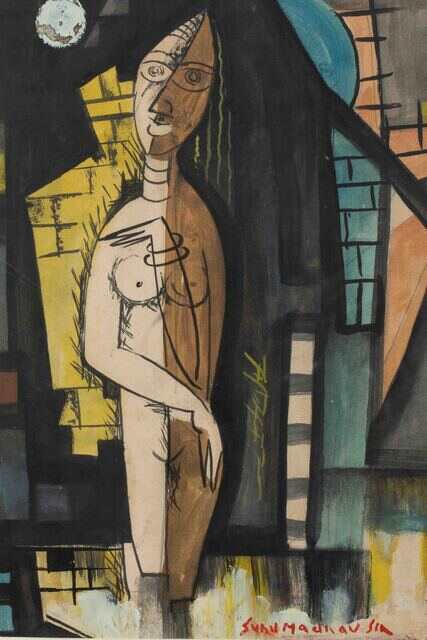 Untitled (Standing Nude), Watercolor on Paper, Sunil Madhav Sen
Untitled (Standing Nude), Watercolor on Paper, Sunil Madhav Sen
He was deeply inspired by Indian folk art, architecture and sculptures such as those in Khajuraho, Konark and Ellora and remained prolific and tirelessly productive. His experiments with relief stone and mosaic chip paintings also received critical acclaim, further cementing his place in the hearts of art lovers. While talking about this creative soul Dr. Klaus Fischer mentioned,
The expression of Eastern mind is not by imitating AJANTA, ELURA and other glories of past but by adding new moderns. Marvellous nude compositions by Sunil Madhav Sen prove that there are forms of international understanding in modern imaginative art. (Art of Sunil Madhav Sen, Oxford Book and Stationary Co. - published by Mrs. Aruna Sen, 1971)
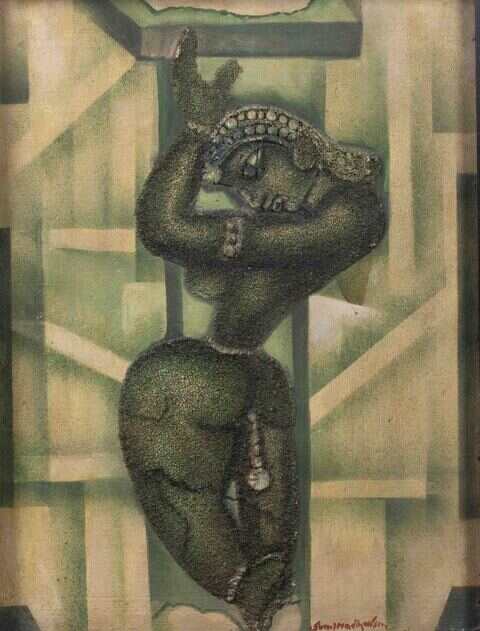 Untitled (Classical Dancer), Mixed Media on Masonite Board, Sunil Madhav Sen
Untitled (Classical Dancer), Mixed Media on Masonite Board, Sunil Madhav Sen
Sunil Madhav Sen’s artistic journey was significantly shaped by his association with the Calcutta Group, and it deepened his engagement with the art world. Initially he was influenced by classical masters like Raphael (Italian painter), Pablo Picasso (co-founder of Cubist movement), Rembrandt (Dutch painter), Guido Reni (famous for his elegant interpretations of religious and mythological scenes in his paintings), Goya (Spanish painter), Renoir (one of the leading French artists of the Impressionist group), Peter Paul Rubens (Flemish artist who is well-known for his mythological and religious paintings). If we notice carefully, we can easily figure out the influences of these artists in Sunil Madhav Sen’s artworks. From 1934-1935 to 1948, he learned a lot by copying these renowned masters.
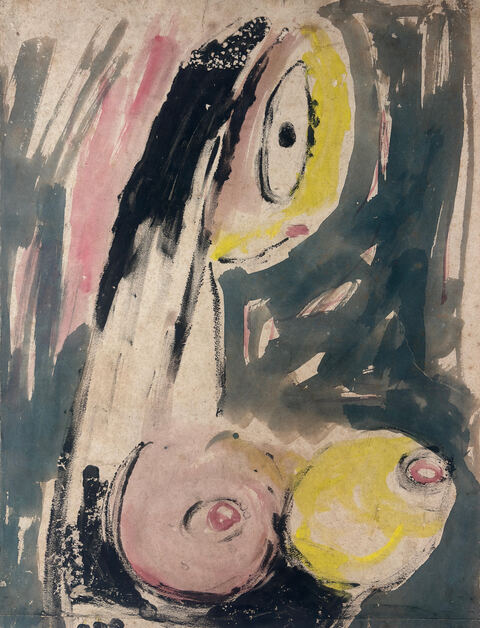 Untitled (Nude Study), Watercolor on Paper, Sunil Madhav Sen
Untitled (Nude Study), Watercolor on Paper, Sunil Madhav Sen
But we can’t take this habit of copying in a negative sense as Jamini Roy also used to follow Impressionist masters in the initial stage of his artistic journey. In Prasanta Daw’s “Sunil Madhav Sen-er Rooplok” (The Aesthetic World of Sunil Madhav Sen; title translated by the blog writer), it is mentioned that while talking about this habit of copying in the early stage of his artistic career, Jamini Roy stated,
Just looking at the old masters’ paintings is not enough. I copy them to understand how they painted them. (translated from “Sunil Madhav Sen-er Rooplok”, page 27)
Maybe Sunil Madhav Sen also had the same kind of perspective and that’s why he used to copy the classical masters to learn their method of using form and color.
In the 1950s, he delved deeply into the subtle intricacies of form and structure, conducting rigorous experimentations. Sheets of metal were seamlessly fused into his canvases, where they danced in rhythmic harmony with color. In his artworks, he also combined oil paints with glue and intricate mosaic work. Among the works from this period, ‘Large Head’ (a glue painting), ‘Primitive Force’ (a mosaic painting), and ‘Primitive Seal’ (a painting incorporating metal leaf) stand out as exemplary specimens. These pieces emanate the mystique of ancient artefacts, resonating with a sense of timelessness. Their palettes echo the muted depth of timeworn oil paintings - shades aged into rich, darkened tones.
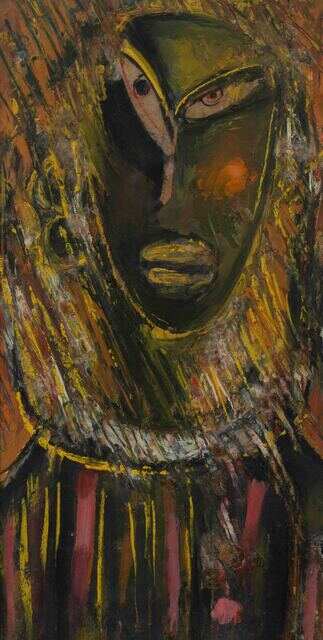 Untitled (Head), Mixed Media on Paper, Sunil Madhav Sen
Untitled (Head), Mixed Media on Paper, Sunil Madhav Sen
Not only that, against a grey-ash colored background, he also created low-relief paintings using mosaic fragments, inspired by the sculptures of Konark, Khajuraho or Ellora. In these works, the painting sought to break free from the confines of two-dimensionality and move towards a three-dimensional form. He also created three-dimensional, abstract leaning artworks using plaster of Paris.
He experimented with glue and zinc oxide on wooden surfaces as well. In his oil paintings on monosite board, the slight elevation of contours lines imparted a sculptural quality, evoking the impressions of engraved reliefs - such as in the figurative representation found in Sita Haran (The Abduction of Sita).
Deprived of formal training from any prestigious art institution, Sunil Madhav Sen carried within him a quiet ache - a sense of incompletion that perhaps became the very fire that fueled his relentless artistic journey. This inner unrest, rather than diminishing him, became the crucible in which he forged a language all his own. Time and again, he dismantled conventional forms only to rebuild it into fresh structures that defied categorization. He drew elements from Western Classical Art, European Modernism, Folk art, Cubism, Nakshi Kantha embroidery, Tantric symbolism, Primitive art and stained-glass windows of churches to create a series of paintings, all marked by his unique style and expressions.
![]() Untitled (Man with a Pipe), Mixed Media on Paper, Sunil Madhav Sen
Untitled (Man with a Pipe), Mixed Media on Paper, Sunil Madhav Sen
Now, if we want to focus on the subject of Sunil Madhav Sen’s paintings, we must accept that ‘Human’ is placed at the center of his artistic exploration. He tried to depict every kind of human emotion on his canvas. His artworks always reflect a deep belief that “Man is the greatest truth.” While talking about the subject of his paintings, Sunil Madhav Sen stated that
I like the beauty of nature. I enjoy it. But I don’t know why it doesn’t seem to appear in my paintings. (translated from “Sunil Madhav Sen-er Rooplok”, page 32)
Sunil Madhav Sen had numerous solo-exhibitions both in India and abroad. His paintings are housed in prestigious institutions such as the National Gallery of Modern Art (New Delhi), the National Library (Kolkata), Jadavpur University and North Bengal University. His portrait of Sarojini Naidu is showcased in the National Leaders’ gallery of the Victoria Memorial Hall (Kolkata), Internationally, Sunil Madhav Sen exhibited his works in cities like Tokyo, Brussels, Newcastle, New York, Sydney and Perth.
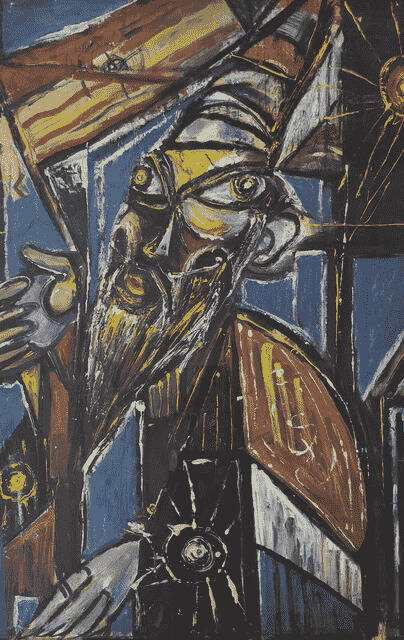 Untitled (Man with a Beard), Mixed Media on Paper, Sunil Madhav Sen
Untitled (Man with a Beard), Mixed Media on Paper, Sunil Madhav Sen
Each artwork of Sunil Madhav Sen stands as a luminous testament to his boundless imagination - where light dances with shadow, where the everyday merges with the ethereal. His brush didn’t merely paint, it revealed. They are not just paintings - they are meditations on beauty, longing and the ceaseless reinvention of form. In conclusion, we can say that Sunil Madhav Sen emerges as a visionary who defied the boundaries of formal training to carve a path uniquely his own. He often stated that “For me there is no joy without color” (“Sunil Madhav Sen-er Rooplok”, page 39). In his every brushstroke we find not just an artist, but a seeker - forever in search of meaning, beauty and the elusive essence of life itself. So, its better to say that his art not only speaks of an era, but of an enduring spirit that dared to reimagine what painting could be.
REFERENCES
- Sunil Madhav Sen er Rooplok, Prasanta Daw, Bharbi Prakashani (সুনীল মাধব সেনের রূপলোক - প্রশান্ত দাঁ)
- Art of Sunil Madhav Sen, Oxford Book and Stationary Co. - published by Mrs. Aruna Sen, 1971